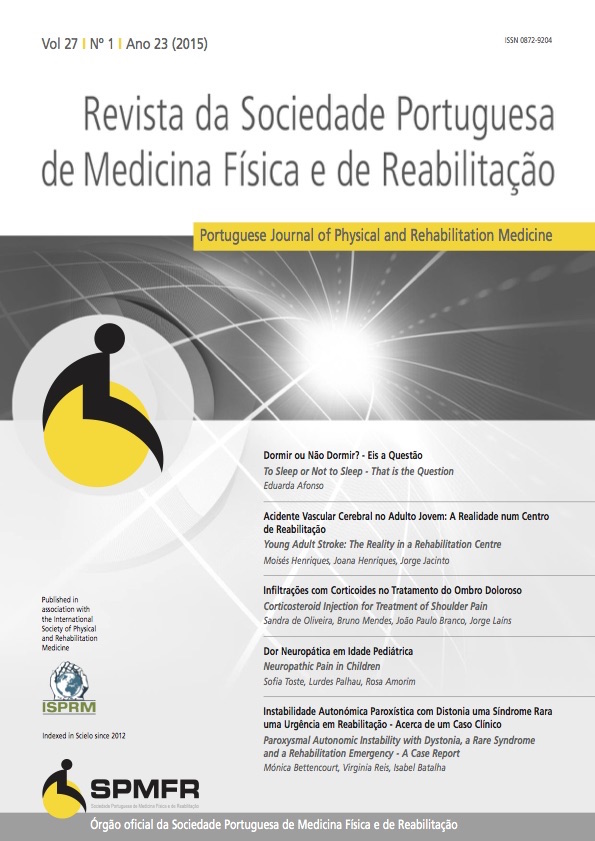Young Adult Stroke: The Reality in a Rehabilitation Centre
DOI:
https://doi.org/10.25759/spmfr.180Keywords:
Stroke/rehabilitation, Young AdultAbstract
Introduction: This study aims to calculate the percentage of young adults among patients admitted with stroke diagnosis in one Rehabilitation Centre service and study the effect of some parameters on the efficiency of their rehabilitation program in the post-acute phase.
Material and Methods: Retrospective, analytical study, drawn up from information contained in the patients admitted in one Rehabilitation Centre service database. Inclusion criteria: hospitalization by cerebrovascular disease diagnosis, namely ischemic or hemorrhagic stroke; first stroke episode and end of hospitalization between January 1, 2007 and December 31, 2012. Exclusion criteria: absence of the event date and readmission. Young adult category was defined for age between 18 and 45 years. It was analyzed the impact of time between event and admission to the rehabilitation centre, type of stroke and laterality on injury inpatient rehabilitation program efficiency in young adults. Z test and t test were used for comparison of proportions and means, respectively.
Results: Among patients admitted to the rehabilitation centre because stroke, the annual percentage of young adults ranged from 5% (2010) and 23.3% (2011). The average efficiency of the inpatient rehabilitation program for young adults decreased with increasing number of days that mediated the event and the admission date to the Rehabilitation Centre. The effectiveness of rehabilitation programs in young adults who have suffered an ischemic stroke (versus hemorrhagic) was slightly better, but without statistical significance.
Conclusions: The results, while not necessarily representative of the national reality, reveal the relevance of addressing the issue of stroke in young adults with the greatest attention. In young adults, the rehabilitation program efficiency in an inpatient rehabilitation centre decreases with the delay between the stroke event and the Rehabilitation Centre admission.
Downloads
References
Gomes A, Nascimento E, Matos L, Martins I, Mos M, Correia J, et al. Acidente vascular cerebral no adulto jovem: estudo prospectivo de 58 doentes. Med Intern. 2008;15:161-8.
Bejot Y, Daubail B, Jacquin A, Durier J, Osseby GV, Rouaud O, et al. Trends in the incidence of ischaemic stroke in young adults between 1985 and 2011: the Dijon Stroke Registry. J Neurol Neurosurg Psychiatry. 2014;85:509-13.
Bejot Y, Daubail B, Giroud M. Epidémiologie et pronostic de l’accident vasculaire cérébral du sujet jeune. Rev Prat. 2013;63:926-9.
Cardoso T, Fonseca T, Costa M. Acidente vascular cerebral no adulto jovem. Acta Med Port. 2003;16:239-44.
Renna R, Pilato F, Profice P, Della Marca G, Broccolini A, Morosetti R, et al. Risk factor and etiology analysis of ischemic stroke in young adult patients. J Stroke Cerebrovasc Dis. 2014; 23:e221-7.
Griffiths D, Sturm J. Epidemiology and etiology of young stroke. Stroke Res Treat. 2011:209370
Ellis C. Stroke in young adults. Disabil Health J. 2010;3:222-4.
Sultan S, Elkind MS. The growing problem of stroke among young adults. Curr Cardiol Rep. 2013;15:421.
Schaapsmeerders P, Maaijwee NA, van Dijk EJ, Rutten-Jacobs LC, Arntz RM, Schoonderwaldt HC, et al. Long-term cognitive impairment after first-ever ischemic stroke in young adults. Stroke. 2013;44:1621-8.
Marini C, Russo T, Felzani G. Incidence of stroke in young adults: a review. Stroke Res Treat. 2011:535672.
Muli G, Rhoda A. Quality of life amongst young adults with stroke living in Kenya. Afr Health Sci. 2013;13:632-8.
Lawrence M, Kinn S. Needs, priorities, and desired rehabilitation outcomes of family members of young adults who have had a
stroke: findings from a phenomenological study. Disabil Rehabil. 2013;35:586-95.
Downloads
How to Cite
Issue
Section
License
Copyright statement
Authors must also submit a copyright statement (as seen below) on article submission.
To the Editor-in-chief of the SPMFR Journal:
The below signed author(s) hereby state that the article
________________________________________ (ref. MFR_________) is
an original unpublished work and all facts stated are a product of the author(s) investigation. This article does not violate any copyright laws or privacy statements. The author(s) also hereby confirm that there is no conflict of interest's issues in this article.
By submitting this article the author(s) agree that after publication all copyrights belong to the SPMFR Journal.
Signed by all authors
Date:
Names (capital letters):
Signatures:
The SPMFR Journal’s contents are follow a Creative Commons licence. After publication the authors can hand out the articles as long as the SPMFR Journal is credited.



